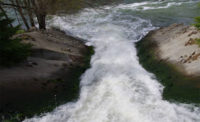..shear walls to avoid importing steel, says the engineer. But because of its lower weight and better use of space, TT won the argument for steel. Three sets of outrigger-belt trusses around the building bind the core with 26 perimeter columns for lateral stability. A similar, two-level arrangement from floor 47, but in concrete, does the same job. Set some 7.5 m apart, columns measure up to 2 x 4 m. TT also designed one-story extensions of the vertical steel elements above and below the trusses to secure them to the surrounding structure.
The two-floor steel outrigger systems at level 33 contains 2,400 tonnes of steel, reports Turner. The four-floor system now being built at level 61 weighs 3,400 tonnes and the two-floor array at level 87 is still in design.
Mirax procured steel sections from Luxembourg and got shop drawings done by K Detailing Inc., New York City, working with a local firm, says Zborovsky. The steel is being fabricated at Belgorod, 800 kilometers away, by Energomash-SBYT.
Bringing in fabricated steel would have been more expensive than importing the raw material, says Zborovsky. The structure complies with Russia’s “SniP” code and with U.S. standards, he adds.
Operating its own construction unit, Mirax “is not a typical developer,” says Turner's Collins. He reports directly to the building’s development company ZAO Mirax City. In parallel, “Mirax Construction manages all the package contractors and they hold all the contracts with the contractors,” he says.
With five site staff, Turner is purely an adviser, although “we are an integral part of the Mirax operation,” says Collins.
When Turner joined the project in 2004, piling had just ended on the smaller building. The main contract had gone, that year, to Turkey’s Ant Yapi Sanayi ve Ticaret Ltd., Istanbul. In 2007, “they finished an acceptable job,” says Collins. China State won its shell-and-core contract in 2005 for about $110 million, he adds.
From the start of construction, Federation Tower broke new ground in Russia. Casting 9,000 cu m in a single pour to form the first building’s 3.5-m-deep piled base slab early in 2005 was unprecedented, says Olga Karpova, a Mirax department director. A year later, 15,000 cu m went into the taller building’s slab.
To cast the taller building’s structural frame, China State established a climbing system that allows formwork for columns, core and slabs to rise concurrently. It was “really very clever,” says Collins.
But when the contractor reached the first outrigger level, it abandoned the system. It cast the rest conventionally, with cores and walls rising independently. The core has now passed level 60. “If we had known about [the outriggers], we could have designed a different system,” says China State’s Yan. The company learned of the need to install them only after it had passed floor 20, he insists.
“Here in Russia, the design changes very often. If we didn’t have the changes, we could have finished by the end of this year,” he says. Yan now forecasts structural completion in mid-2009 at the earliest.
China State employs about 500 Chinese workers on the job, all housed in a construction camp. Western project staff who have visited the camp say living standards are worse than in the Middle East. They report at least one industrial dispute, but Yan has no recollection of it.
Completion of the tower is now not forecast until around the end of 2010. With Moscow’s sky-high rents steadily rising, at least until the recent crisis, “there was not a strong emphasis on speed,” says Lassen.



Post a comment to this article
Report Abusive Comment